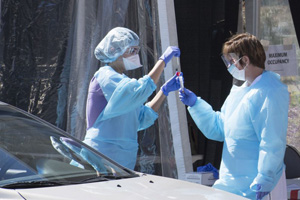
The COVID-19 Public Health Crisis
Public health rests on both epidemiology and emergency preparedness. In an outbreak of an infectious disease, it is the science of epidemiology that defines the who, what, why, when and where of the response, while emergency preparedness planning provides the framework for that response, along with the flexibility and scalability to meet any disaster when it occurs.
On March 11, 2020, the World Health Organization’s Director General, Dr. Tedros Adhanom Ghebreyesus, declared COVID-19 a pandemic, stating that this public health emergency would “touch every sector” and require countries to “take a whole-of-government, whole-of-society approach” to saving lives and minimizing the pandemic’s impact.
Public health, with its goals of preventing disease, promoting health and prolonging life, comprises a complex system affecting almost every facet of life, both in health and disease. Because its activities are population-based, most of its work remains in the background, out of sight and many times out of mind—until a public health crisis occurs. And COVID was a perfect storm.
Pandemic planning and response focuses on emergency preparedness, epidemiology and infectious diseases. In an outbreak of an infectious disease, it is the science of epidemiology that defines the who, what, why, when and where of the response, while emergency preparedness planning provides the framework for that response, along with the flexibility and scalability to meet any disaster when it occurs.
Repeatedly, preparation has proved the Achilles heel of disaster response. We humans are not long-term planners, or thinkers or doers.
A good example of emergency preparedness is the common emergency of fire. We all understand how preparedness can make us less vulnerable to a fire. Most of us take the smoke detectors, fire extinguishers and sprinkler systems for granted. We assume, if we think about it at all, that someone is taking care of testing and maintaining the equipment, swapping out any outdated equipment, and complying with fire codes and safety regulations. We may be called upon at times to go through fire drills, which we may or may not do—maybe we even complain about the inconvenience. But this practice helps people know what to do and how to do it when a fire emergency occurs. It may never happen to you—and most likely will not—but if it does, you would want to have a plan and to know that plan. When a fire actually occurs is when you find out how effective all that planning, training and preparation have been, but it’s not intuitive. You must practice what to do and when. Do you always know where your nearest exit is? Or what you should do when a fire strikes?
Repeatedly, preparation has proved to be the Achilles heel of disaster response. We humans are not long-term planners, or thinkers or doers. And, as we shall see, those shortcomings were magnified in the US COVID-19 response.
The most common mechanism for a novel pathogen to evolve is zoonosis, thought to be the most likely origin of the SARS-CoV-2 virus. In this scenario, a coronavirus which is commonly found in animal hosts like bats or pigs is allowed to co-exist within its host animal. This creates a biological mini-laboratory where the host animal becomes tolerant of the guest virus, allowing it over time to continue mutations or exchange of genetic material until it becomes a novel pathogen able to reinfect the original hosts or to infect a new host.
When a new viral pathogen is allowed to incubate and adapt to its new host, it can potentially develop the ability to jump from one human to another, as COVID did. We’ve known about and planned for years for just such a scenario, and since 2000 we’ve even had an emergency plan to identify and contain these global outbreaks. In 2005, 196 countries agreed to abide by International Health Regulations that required reporting of potential public health emergencies worldwide.
This agreement was supposed to complement the Global Outbreak Alert Response Network (GOARN) formed in 2000, which monitors six regions—the Americas, Europe, Africa, Eastern Mediterranean, Southeast Asia, and Western Pacific—and comprises 300 technical institutions across 90 countries. GOARN provides technical expertise and networks around the world to coordinate and assist WHO Member States in responding to public health emergencies such as disease outbreaks.
So the potential for outbreaks was foreseen and planned for with a system of rapid detection and response. The scientific detective work of the epidemiologist enables recommendations concerning identifying cases and tracing contacts of infected persons; identifying who is vulnerable and what organism might be involved; and determining how the disease spreads. Based on that information, epidemiologists can make recommendations for protecting against infection and preventing further spread. Finally, they communicate those findings and recommendations to all concerned so that the outbreak is contained and the spread among the population is reduced and eliminated.
The Response
International disease-surveillance systems were ready in the winter of 2019, but they were hampered by delays in investigating and in sharing all the details of the outbreak in China. And in the US, the failures of an unprepared nation became increasingly evident. Stockpiles of emergency supplies had been allowed to diminish. Just-in-time manufacturing made supply chains and turnaround times lengthen as business ground to a halt globally. Business closures and loss of public demand caused thousands of businesses to fail and food lines to lengthen as budgets and savings were stretched to the limit.
By the end of 2020 the first vaccines tailored to boost the body’s defenses against the virus causing COVID were introduced to the public—a truly amazing feat.
The WHO distributed test kits to 57 countries by January 2020, but in the US the federal Centers for Disease Control and Prevention (CDC) was still the only lab testing for the virus, and it quickly fell behind. It wasn’t until early February that state labs were given the test kits developed by the CDC, but a defective reagent that supplied false negatives made them useless until it was remedied—at the end of February. For the next nine months while waiting for a vaccine to be developed, the US population was at the mercy of an overwhelmed public health system ineffectively attempting to isolate infected individuals, identify their contacts, and quarantine the exposed. Labs permitted to do the PCR test for COVID-19 exposure, which gave results in several hours, quickly became backlogged for days or weeks, making identifying those needing isolation or quarantining even more challenging. For months the only options for prevention were non-pharmaceutical interventions such as social distancing, hand washing and—after initial miscommunication—wearing of masks. Large indoor gatherings, and eventually all indoor gatherings, were discouraged or prohibited while businesses, schools and society slowed to a virtual crawl, if not a halt.
By the end of 2020 the first vaccines tailored to boost the body’s defenses against the virus causing COVID were introduced to the public—a truly amazing feat. The pharmaceutical companies streamlined their efforts by starting large-scale manufacturing of the vaccines during clinical trials and combining clinical-trial phases or running them concurrently.
New vaccines by Moderna and Pfizer were built on the mRNA platform, a prototype under investigation since 1990 and quickly adapted to the new vaccines owing to its potential for a more streamlined production once a successful vaccine was identified. (Johnson & Johnson also developed a vaccine that was plagued early on with concerns about side effects and is no longer available in the US.)

The speed at which this vaccine went from design to testing to public distribution was largely the product of Operation Warp Speed, an enormously successful collaboration between the US Department of Health and Human Services and the Department of Defense. This entity was created to rapidly take the vaccines from production and testing to distribution in the US. This multiorganizational effort saved millions of lives, as it was the fastest any vaccine had been produced owing to the coordination and overlapping of testing and production phases. Prior to this, the fastest vaccine development had been three years for the mumps vaccine, and prior to that, five to ten years was the norm. Other global initiatives proved successful as well, including COVAX (COVID-19 Vaccines Global Access) and the vaccines developed independently by China and Russia. At a cost of 99 million dollars, seven companies eventually brought potential vaccines to clinical trials, several by the targeted deadline of January 1, 2021.
From 2020 to the present time, repeated waves of COVID infections continue to highlight the virus’s relentless ability to mutate and change. The vaccines are repeatedly adapted in response, and the most vulnerable populations have been asked to consider vaccination approximately every six months. Today, the unvaccinated remain the most vulnerable to dying from COVID. Medications like Paxlovid are recommended for those most likely to get seriously ill, while COVID, home antigen tests, and masking have all become common facts of life. For the vast majority, life has resumed, though not without changes such as working from home, online venues for everything from work to entertainment to food and grocery shopping, and now there is a travel boom as the population makes up for lost time.
External Stories and Videos

Has our dishonesty prolonged the pandemic and increased the spread of this deadly disease?
UPI
At the height of the COVID-19 pandemic, more than 40% of Americans were untruthful about whether they had the virus or were ignoring safety precautions.
